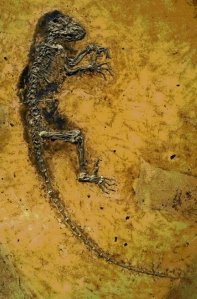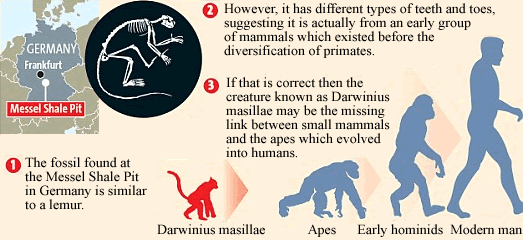Missing Link fossil discovery
Ida - Darwinius masillae - earliest ancestor

.gif)
|
Was Ida / Darwinius masillae one of our earliest ancestors and does
her discovery mean that the Missing Link has been found?
Fig. 1A of the PLoS ONE article about the Ida fossil, published under the Creative Commons Attribution License;
any reuse should cite the authors and journal.
Full citation details here
|
|
Has the " Missing Link " been found ?
The story of a possible missing link fossil discovery that has been given the familiar name " Ida " after the young daughter of one of the research team's leaders
and also the scientific
name Darwinius masillae, (to celebrate Messel, her place of origin, and the bicentenary of the birth of Charles Darwin),
has become the
subject of a special TV production hosted by the well-known natural history broadcaster Sir David Attenborough.
This possible Missing Link fossil discovery was originally made, by amateur collectors in 1983,
at the Messel Shale Pit, (a former quarry!),
near Darmstadt, and
some 35 km southeast of Frankfurt am Main, Germany. Messel Pit
was already famous for frequent yieldings-up of
interesting fossils and eventually became famous enough, with the discovery of such fossilized creatures as
mini-horses, bats, a possible anteater and a tapir,
to be declared a World Heritage Site by UNESCO in December, 1995.
It seems inevitable that the acceptance of Ida - Darwinius masillae as a
fossil of the first importance will only add to that fame.
The Ida fossil seems to have been recovered in two portions from the splitting open of a block of shale from
Messel Pit. The split shale yielded a part bearing the main fossil elements and a counterpart bearing features
that were
mostly just a corresponding impression of the fossil itself. The less complete, counterpart, portion was known
to science having been purchased in 1991 by the privately run Dinosaur Center at Thermopolis, Wyoming.
The ground-breaking research into the Ida - Darwinius masillae fossil was only made possible after Norway’s National
History Museum managed to buy the the more truly "fossil bearing" portion of the original from a private collector.
Dr. Jørn H. Hurum, a paleontologist at the University of Oslo and a leader of the research,
subsequently arranged for a team of German and American scientists to study the fossilized bones with
CT (i.e. Computed Tomography) imaging and other advanced technologies.
Using contemporary CT imaging technology it is possible to "virtually" cut fossils into digital slices by
running them through a supercharged CT scanner, that resembles a medical CAT scanner
but has much more power available for image capture. It is currently possible obtain somewhere in the region
of 400 "digital slices" across a depth equivalent to the head of a pin - and in much finer details than medical CAT
scans, as radiation exposure is not an issue with animal remains.
![[lemur monkey species]](jumping_lemur.jpg)
A lemur jumping between tree branches
Adapids, or the Adapidae, are a now extinct family of lemur-like creatures related to early primates.
The new Ida / Darwinius masillae fossil discovery is that of a nearly complete
specimen of a young female Adapid that would have weighed just 0.90-0.95 kg., or 2lb, when fully grown. Ida
was less than a year old but had been weaned and had developing teeth.
The Messel Pit is believed to have begun its
existence as a volcanic caldera lake in which billions
of algae bloomed and the expiry of these billions of algae tended to produce oxygen-poor conditions in the lower
levels of the lake within
which the remains of deceased animals birds and plants could be very slowly fossilized and
without being disturbed by disruptive predators or scavengers.
Due to
this lack of natural disturbance, or "bioturbation", the fossil bodies of some specimens
are surrounded by a so-called Hautschatten ('skin shadow'). This dark area, formed out of fossilized
waste materials discarded by bacteria as they slowly consumed deceased animals and birds, even
preserves impressions of plumage on birds and
the individual hairs of mammals. The wing membranes and details of external ears are known from bats.
The Darwinius masillae fossil has been described as the “most complete fossil primate ever
discovered,” lacks only the lower left limb, and due to the special conditions
prevailing at Messel impressions
of Ida's fur and of her soft body outline are discernable - the remains of her last meal - comprising
fruit and leaves - have been detected in the stomach cavity.
The completeness of this fossil discovery has allowed paleontologists to gain new insights into the Adapid family.
![[ida transitional species sketch from fossil evidence ]](ida_sketch.jpg)
.gif)
|
|
This sketched representation of Ida, and her kind, is taken from the
report published by the research team on the Public Library of Science web site.
The image is Fig. S6 of the PLoS ONE article, published under the Creative Commons Attribution License;
any reuse should cite the authors and journal.
Full citation details here
| |
After two years of secretive preparation full details of the project that became the Darwinius masillae study
were given at a fanfare launch at the
academically prestigious American Museum of Natural History on Tuesday, May 19, 2009, arrangements also having been
put in place for an associated TV special, entitled " Uncovering our earliest ancestor : The Link ",
to be rolled out world-wide.
The project apparently had its origins in December, 2006, at a mineral and fossil fair in
Hamburg where Dr. Hurum got into conversation with a private fossil dealer named Thomas Perner
who was already known to him and who,
over fruity vodka drinks, showed him a few photographs of the fossil, which had been found at Messel
Pit in 1983 and had subsequently
been hanging on the wall in the house of a German collector.
Herr Perner discreetly advised Dr. Hurum that the fossil had already been quietly "on the market" for some
six months at an asking price of, wait for it, more than $1,000,000.
It seems that at least two prominent German museums had already been approached, possibly with the same
or similar photographs,
but had baulked at this asking price for a fossil that they had not found to be of proven merit.
A certain amount of forgery, fakery, and interpretative reconstruction, is known to go on
in the fossil-collecting world so participants in the fossil market need to be both knowledgeable and careful.
Dr. Hurum, a fossil expert, was so excited by what he saw in these pictures, ("I knew that the dealer had a world sensation in
his hands"),
that he reportedly
“could not sleep for two nights, just thinking about this specimen.”
Back home in Norway Dr. Hurum reported
news of this extra-ordinary fossil and its equally extra-ordinary asking price to his colleagues.
Although Dr. Hurum does not seem to have actually actually expected it funds were found such that he was able to enter into
negotiations leading to the purchase of the fossil.
Referring to an already celebrated missing link fossil discovery, that of an Archaeopteryx, which was
also originally found in Germany and purchased by a museum in London
in 1861, (just two years after the publication of Darwin's Origin of Species!), and which later
provided key evidence of Dinosaur-Era
life forms in a transitional phase towards the emergence of bird-like life forms, Dr. Hurum is on record as stating:-
“I realized at first it’s a primate. It just screams primate: opposable big toes and thumbs, no
evidence of claws. This is like the Archaeopteryx of primate evolution.”
The researches have concluded that this fossil was of a creature that was "not simply a lemur" and that its
discovery "is going to advance our knowledge of evolution".
Darwinius masillae differs from lemurs in two key ways - it does not possess the "toothcomb" set of
lower front teeth lemurs use to groom fur or the "toilet claws" on the hind feet the lemur family tend to use
for scratching leading the researchers to depict it as having been a "Lemur-Monkey".
![[darwinius toilet claws toothcomb]](toothcomb.jpg)
A bone in Ida's ankle called the talus is shaped like that members of our own, Anthropoid, branch of the
primates. Ida's nail-bearing fingers and toes also confirm her to having been a primate.
![[darwinius toilet claws toothcomb]](Talus_bone1.jpg)
It would seem that
this extraordinary fossil “is important in being exceptionally well preserved and providing a much more complete
understanding of the paleobiology” of a primate from the Eocene period. The Greek derived word, Eocene,
actually translates as "New Dawn", and it is in the Eocene that larger mammals are believed to
have made their first appearance.
Is this really a Missing Link fossil discovery?
Has one of our earliest ancestors been found?

In May, 2009, the study of Ida - Darwinius masillae, for some two years a closely guarded secret,
was given an unprecedentely high-power PR launch. A few days prior to the actual launch date press releases
about it were issued on behalf of the organisers. All in uppercase ome of the press releases read:-
"MEDIA ALERT," - "WORLD-RENOWNED SCIENTISTS REVEAL A REVOLUTIONARY SCIENTIFIC FIND THAT WILL
CHANGE EVERYTHING."
At the launch presentation itself ambitious words were used such as the "Missing Link to
our Earliest Ancestors" and the "Rosetta Stone of Human Evolution".
Comparisons of cultural importance
were made with the Mona Lisa and to the Moon Landings.
During the proceedings at the American Museum of Natural History Dr. Hurum said:-
"It is the scientific equivalent of the Holy Grail. This fossil will probably
be the one that will be pictured in all textbooks for the next 100 years."
It may be that the Ida - Darwinius masillae fossil will readily become accepted as being
a transitional fossil of an early lemur-monkey from the time, 47 million years ago, when
lemurs and monkeys were diverging as species.
A particularly
important clue to her eventual placing in the Primate Evolutionary Tree may arise from the very completeness of this
fossil if researchers
are ultimately able to discern whether or not this fossil was of a creature that had
a "wet" nose.
Modern primates are divided into two suborders: the strepsirrhines, or “wet-nosed” primates,
include lemurs, bushbabies
and lorises, while the haplorrhines or “dry-nosed” primates include monkeys, apes and humans.
In preparing their report the research team referred to an number of already accepted strepsirrhine
and haplorrhine characteristics and, on that basis, have actually gone so far as to place Ida as clearly tending
towards being a haplorrhine rather than a strepsirrhine.
The researchers believe Ida may be on our own evolutionary line dating from just after the split with the lemurs and
that this fossil is from "a transitional species showing characteristics from both the non-human
(prosimians and lemurs) and human (anthropoids, monkeys, apes and man) evolutionary lines".
To quote the research teams
report, “Darwinius masillae, and adapoids contemporary with early tarsioids, could represent a stem group from
which later anthropoid primates evolved, but we are not advocating this here, nor do we consider either Darwinius
or adapoids to be anthropoids".
Dr. Philip Gingerich, a leading American primate
specialist based at the University of Michigan, president of the American Paleontological Society
and co-author of the Darwinius masillae study, went so far as to state that:-
“This discovery brings a forgotten group into focus as a possible
ancestor of higher primates.”
A close colleague of, and indeed, collaborator and co-author with, Drs. Gingerich and Hurum on the two-year study of the Ida fossil, Jens Franzen, of the Forschungsinstitut Senckenberg, Frankfurt,
Germany, which has an overseeing role for the Messel Shale Pit World Heritage Site, was also at the launch
ceremony and hailed the Darwinius masillae / Ida discovery as "the eighth wonder of the world" but also stated that "we're not dealing with
our grand, grand, grandmother, but perhaps with our grand, grand, grand aunt" and that "she belongs to the group from which
higher primates and human beings developed but my impression is she is not on the direct line."
Moreover, the closing sentences of the body of the academic study available online are perhaps somewhat
restrained in the claims they seem make about
this possible Missing Link fossil discovery.
Morphological characteristics preserved in Darwinius masillae enable a rigorous comparison with the two principal subdivisions of living primates: Strepsirrhini and Haplorhini. Defining characters of Darwinius ally it with early haplorhines rather than strepsirrhines. We do not interpret Darwinius as anthropoid, but the adapoid primates it represents deserve more careful comparison with higher primates than they have received in the past.
Darwinius masillae is important in being exceptionally well preserved and providing a much more
complete understanding of the paleobiology of an
Eocene primate than was available in the past.
Full citation details here
Since May 2009 two other serious studies have actually placed Darwinius Masillae on the strepsirrhine
rather than haplorhine evolutionary branch.

|
|
![[missing link fossil discovery earliest ancestor found volcanic lake]](evolution.gif)
![[missing link fossil discovery earliest ancestor found volcanic lake]](evolution.gif)
![[lemur monkey species]](jumping_lemur.jpg)
![[darwinius toilet claws toothcomb]](toothcomb.jpg)
![[darwinius toilet claws toothcomb]](Talus_bone1.jpg)

